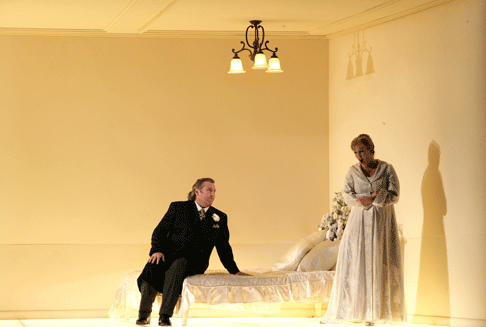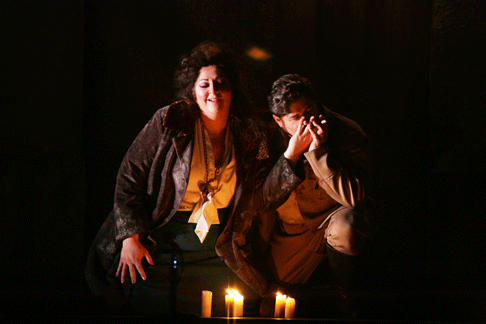11 Nov 2009
Lohengrin in Houston: A long-awaited return
Wagner was last on stage in Houston’s Wortham Theater Center in 2001, when the Houston Grand Opera staged Tannhäuser.

Wagner was last on stage in Houston’s Wortham Theater Center in 2001, when the Houston Grand Opera staged Tannhäuser.
That production brought down the curtain on a decade that was a Golden Age for German opera at the HGO. During the previous dozen years Wagner was on stage at the Wortham in nine seasons and Richard Strauss in two.
There was a reason for this richness — and for the dearth that followed. Those were the banner years when Christoph Eschenbach was music director of the Houston Symphony. Not only did he conduct Wagner and Strauss at the HGO; he brought his orchestra into the pit at the Wortham for these performances. Years of transition followed that marked a period of maturation for both the HGO and the HSO. As they grew in quality and significance, the Opera was challenged to build its own ensemble.
Thus the production of Lohengrin that opened at the Wortham on November 30 was not only a “long-awaited return,” as HGO music director Patrick Summers described it in an erudite note in the Lohengrin program. It was further a milestone in the history of the company and in the career of Summers, HGO music director since 1989.
It was to Summers that the building of an opera orchestra was assigned, and — as was gloriously apparent in the new Lohengrin — he has done this with impressive success. Indeed, the hushed celestial silver of the violins that opens the Overture shimmered in warmth as they ascended to the unashamedly erotic heights that launch the first act of the work.
The profound feeling that Summers brought to the Overture and all that followed made it difficult to believe that this was the first complete Wagner opera that he has conducted. All this distinguished this new Lohengrin as a turning point in the history of the 54-year-old HGO. Evaluation of the production itself is a more difficult matter.
This was also the first Wagner for director Daniel Slater and designer Robert Innes Hopkins and one can only wish that their work had been on the same level as Summer’s achievement with the orchestra. Such — alas — was not the case. The two badly overshot their mark in an arsenal of effects the sum of which was far less than their collected value.
In this co-production with Switzerland’s Grand Théâtre de Genève, where the staging debuted in 2007, the British collaborators were perhaps a bit too eager to try their hand at what is known on the continent as Regieoper, the approach that allows the production team free rein in the liberties it takes with what the composer once regarded as a finished work. (The result is often summed up as “Eurotrash.”) Gone — along with the traditional swan — was the knightly medievalism that is traditionally the historic background of Lohengrin.
 Simon O’Neill (Lohengrin) and Adrianne Pieczonka (Elsa)
Simon O’Neill (Lohengrin) and Adrianne Pieczonka (Elsa)
Act One opened in a cavernous library, obviously long neglected. Uniforms — for those old enough to remember them — recalled Eastern Europe in its totalitarian bad days. Things get worse as troops viciously tore books from shelves, recalling — again for those with knowledge of early 20th-century history — the Nazi book burning in Berlin when Hitler came to power. (That conflagration was staged, incidentally, on the square adjacent to the Staatsoper on historic Unter den Linden.)
Simon O’Neill, whose grubby dress, hair and demeanor bore little resemblance to the man in shining armor that Lohengrin, this Knight of the Grail, is supposed to be. O’Neill was vocally disappointing as well, for — although his voice is of some power — it lacks warmth and shading. Indeed, his performance was largely monochromatic.
The Elsa was Canada’s Adrianne Pieczonka, praised throughout Europe today for her interpretation of the women created by Wagner and Richard Strauss. In Act One Pieczonka’s voice seemed a trifle two mature for innocent Elsa, but in Act Two she was a perfect match for Christine Goerke, whose Ortrud was the glory of this staging.
Although Goerke, long an established Wagnerian, might have sued designer Hopkins for the dreadful green cocktail dress in which she first appeared, she soon proved herself the strongest member of this cast, stressing that behind every evil man there is an even more evil woman.
 Richard Paul Fink (Friedrich of Telramund) and Christine Goerke (Ortrud)
Richard Paul Fink (Friedrich of Telramund) and Christine Goerke (Ortrud)
Richard Paul Fink, long the world’s most sinister Alberich in Wagner’s Ring and the creator of Mephistophelean Edward Teller in John Adams’ Doctor Atomic, was a natural as Ortrud’s partner in malice. However, one expected a more significant voice than bass Günther Groissbock brought to King Heinrich. Supporting roles were impressively sung by HGO studio artists.
Lohengrin contains Wagner’s greatest choruses, and HGO chorus master Richard Bado brought home that no American company has a better choral ensemble than Houston. Although the ludicrous aspects of the staging did not necessary detract from the musical excellence of the production, a concert performance by Summers and his forces would have been more satisfactory. The good news associated with this production is that the HGO henceforth promises a German opera — Wagner, Strauss or Beethoven — in each future season.
“Now,” Summers concludes, “HGO rejoins a perpetual journey into one of history’s true, if disquieting visionaries.”
Wes Blomster